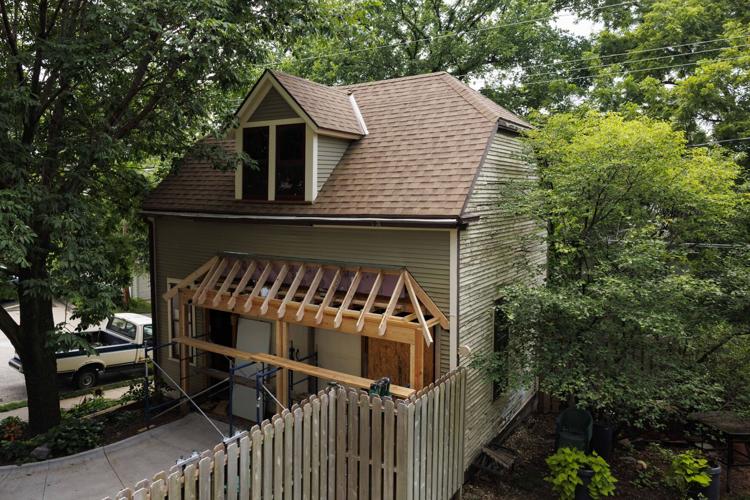With five children and 24 grandchildren, Luther and Debra Larson figure the accessory dwelling unit they’re adding in what was originally a hayloft above their garage at 40th and Cass Streets will come in handy.

Luther and Debra Larson are adding an accessory dwelling unit above their garage, which was originally an urban barn, behind their home in the Joslyn Castle neighborhood in Omaha. The city changed zoning regulations a year ago to make it easier to build ADUs in more areas of the city.
It could provide extra space during family gatherings or serve as a retreat for the couple if they decide to rent their historic home during an event like the College World Series. A granddaughter, a high school student considering attending Creighton University, is already eyeing it as a potential residence. And creating the living space made sense since they were already bumping out the front of the building so they could add a second door and create a two-car garage.
“It’ll be a cozy little spot,” Debra Larson said.
Their accessory dwelling unit, or ADU, is one of the first to undergo the city’s approval process in the roughly one year since the City of Omaha opened the door to more of these residences within its boundaries.
People are also reading…
In March 2024, the Omaha City Council adopted an ordinance changing zoning regulations to allow accessory dwelling units citywide and to streamline the city processes for approving them.
An accessory dwelling unit is an additional small house or apartment set on a single-family residential property. Omaha has offered such residences for generations, especially in older, established neighborhoods like the Larsons’. Examples include carriage houses, apartments over garages and mother-in-law suites where aging parents could live in smaller quarters while their children raised families in the main house.
City planners and other proponents see ADUs as one way to address a critical shortage of affordable housing in Omaha. The changes approved last spring were the first recommendation to be enacted from the city’s Housing Affordability Action Plan, which the council adopted in December 2022.
Under the changes, ADUs now are permitted outright in 10 zoning districts that generally allow for greater density. Owners just need a building permit. In 10 other districts zoned for lower density, such as Omaha’s suburbs, would-be ADU builders must seek a conditional use permit, which must be approved by the Omaha Planning Board.
Eric Englund, the city’s assistant director for urban planning, said the city as of a month ago had issued about 10 building permits for ADUs since the change. An additional 10 or more have gone through the planning board.
“It’s not a huge number when you’re talking 20-25 in a year,” he said. “But that’s OK. There is a lot of interest.”

Luther Larson walks up the stairs in his garage, which was originally an urban barn, to where an accessory dwelling unit is being built behind his home.
The city expects more of the smaller dwellings to go up as the idea catches on, Englund said, although they’re not expected to rise by the thousands. And there still are a few details they’re working through, including talking with bankers about how to finance them. That’s an issue that has arisen nationally, as well. Last week, according to the Wall Street Journal, a pair of congressmen from California and New York unveiled a bill that would create a government-backed loan program for homeowners to finance the housing units.
Todd Stubbendieck, state director of AARP Nebraska, said making the zoning changes was a critical first step. AARP Nebraska joined a number of real estate developers and homebuilders in supporting the zoning changes.
“If there’s 25 ADUs being built in Omaha this year, that’s a step in the right direction for us,” he said.
Now backers need to continue to provide education about the value of and the many uses for the dwellings, he said.
While they alone won’t solve the city’s housing shortage, they represent an important family-friendly and age-friendly housing option. Older adults, for instance, may choose to have an ADU that can house a family member or caregiver. Or a family may have an ADU that houses an older relative.
That message will spread as more are built, he said. That’s also the reason AARP Nebraska partnered with the city, Omaha By Design and others to install the model ADU at the Riverfront at the 8th Street Plaza at Heartland of America Park earlier this summer. It’s based off a design by Alley Poyner Macchietto Architecture that won first place in AARP and the City of Omaha’s ADU for U competition. It will remain on display until October, when it will be donated to an affordable housing program.
The city, meanwhile, has created a separate website called ADU Omaha with more information. It also includes eight plans, one of which is free and pre-approved.
Jared Gerber of Gerber Architecture, who designed the Larsons’ ADU and some other early projects, said most of the queries he gets from potential clients about ADUs involve adding separate units in their backyards for aging parents. Others have mentioned adding vacation rentals and one who was leasing a home to a long-term renter was considering adding quarters to use while visiting the city.

Debra Larson holds the plans for adding an accessory dwelling unit above the garage at the family home in the Joslyn Castle neighborhood in Omaha.
Nor are the units sprouting just in places like Midtown and North and South Omaha, where residents long have been familiar with them. He has one in the works that would be attached to a new home near Fort Street in northwest Omaha.
Englund said the city has seen recent applications for units off 244th Street and West Dodge Road and near Mount Michael Benedictine Abbey.
“It’s been a little bit surprising,” he said. “The ones that have come through planning board have been in really different parts of the city.”
The city, he said, required conditional use permits in areas with less density because planners thought it was important to give neighbors a chance to weigh in publicly with concerns.
Jesse Bowdino was among those seeking a conditional use permit for an ADU in a less traditional area of the city. He also flipped the model on its head: He wants to eventually build a larger house for his growing family on a 6.5-acre lot near 258th and Pacific Streets, which he recently purchased from his parents.
As part of the deal, his grandparents would continue to live in the smaller renovated farmhouse on the property, which would become the ADU. Having lived mostly in Oregon and Montana, they wanted to remain outside the city proper.
“They love it out there,” Bowdino said.
In addition to seeking a conditional use permit, he said, he also had to seek a waiver to put the primary house behind the ADU. The city usually requires the primary dwelling to be in front.
“I was kind of dreading it at first,” he said of the application process. “But it actually turned out to be pretty easy working with the city.”
Gerber said he ran into a similar issue with the project he’s working on in northwest Omaha. While detached ADUs are supposed to be behind the principal dwelling, according to city code, the rules didn’t specify the layout for attached units. Because such gray areas remain, the city typically recommends a pre-meeting with interested parties.

The space that is being turned into an accessory dwelling unit at the residence of Luther and Debra Larson has a vaulted ceiling.
Owners also may need to assess utility options. The Metropolitan Utilities District offers a couple of options for providing natural gas and water based on the type of ADU and location of the lot. The utility encourages customers to contact its Builder Hotline at 402-504-7014 to explore costs and service options. The utility has received about 10 applications related to ADUs since the zoning change.
Both Larson and Stubbendieck noted that such dwellings aren’t necessarily cheap to build. Larson said connecting his garage to water and sewer cost about $15,000.
But Stubbendieck said those interested in adding ADUs, especially those seeking to age in place or care for aging loved ones, also need to consider that assisted living can cost $4,000 a month and skilled nursing care considerably more.
The future, on the other hand, may bring new financing options, he said. The city could further ease such projects as it continues through its multiyear effort to update its comprehensive plan, which contemplates that the city will run out of land for western development in 30 years.

Luther and Debra Larson are adding an accessory dwelling unit above their garage, which was originally an urban barn, behind their home in the Joslyn Castle neighborhood in Omaha.
The Larsons, for their part, are no strangers to creating new dwellings from old ones. Their home is the seventh in the Cathedral-Duchesne area that they have restored since Luther Larson retired a dozen years ago. Known as the tin house, it was built in 1905 by Gustave F. Epeneter, who owned Eagle Cornice Works, and features extensive stamped metal details on the exterior and some intricate tin ceilings inside.
Completing the ADU will require adding an outside deck and stairway on the north side of the building and crafting woodwork to match the main house.
“It’s cool to bring houses back to life,” Debra Larson said. “But it’s a lot of work.”
Our best Omaha staff photos & videos of July 2025

Layla, the dog runs around while outside while at the Nebraska Humane Society in Omaha on Friday, July 7, 2025. Nebraska Humane Society is doing special pricing on pets to help find room for needy animals from Texas flooding.

People watch fireworks go off in the sky during the annual firework show in Ralston on Thursday, July 3, 2025.

Theodore the dog shakes water off after jumping into a pool at Omaha Dog Bar, 1231 S 14th St., in Omaha on Thursday, July 3, 2025.

From left, Noah Winslow, 10, Isaiah King and Lamarus Secret fish at Benson Park in Omaha on Wednesday, July 2, 2025.

Talons' Ali Aguilar (3) fields a ball hit by Bandits' Sydney McKinney (26) during an Athletes Unlimited Softball League game at Connie Claussen Field in Omaha on Friday, July 11, 2025.

Bandits' Delanie Wisz (97) scores ahead of the tag by Talons' Sharlize Palacios (13) during the eighth innning during an Athletes Unlimited Softball League game at Connie Claussen Field in Omaha on Friday, July 11, 2025.

Bandits' Erin Coffel (21) is called out after being tagged by Talons' Hannah Flippen (19) trying to steal duing the seventh inning during an Athletes Unlimited Softball League game at Connie Claussen Field in Omaha on Friday, July 11, 2025.

Talons' Sierra Sacco (21) celebrates tying the game on a home run in the bottom of the seventh inning during an Athletes Unlimited Softball League game at Connie Claussen Field in Omaha on Friday, July 11, 2025.

Dylan Raiola leads a group of campers during his first youth football camp in Lincoln on Saturday, July 19, 2025.

The Talons lift Ali Aguilar (3) after she drove in the game-winning run in extra innings during an Athletes Unlimited Softball League game at Connie Claussen Field in Omaha on Friday, July 11, 2025.

Bandits' Bella Dayton (6) can't catcht his home run by Talons' Jadelyn Allchin (90) during an Athletes Unlimited Softball League game at Connie Claussen Field in Omaha on Friday, July 11, 2025.

Talons' Hannah Flippen (19) celebrates a third-inning home run during an Athletes Unlimited Softball League game at Connie Claussen Field in Omaha on Friday, July 11, 2025.

A crash near the 14th Street closed westbound I480 in Omaha on Friday, July 11, 2025.



















